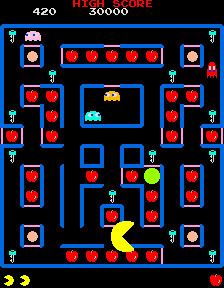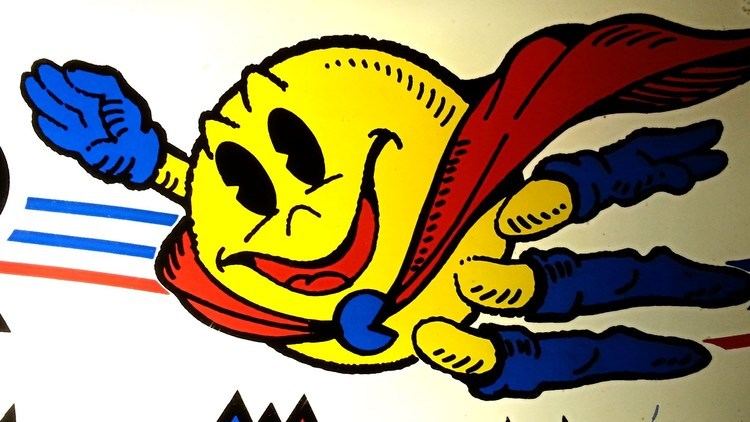9.6 /10 1 Votes9.6
Composer(s) Nobuyuki Ohnogi Initial release date 1982 Designer Toru Iwatani | 4.8/5 Emuparadise | |||||||||||||||||||||||||||||||||
 | ||||||||||||||||||||||||||||||||||
Mode(s) Up to 2 players, alternating turns Cabinet Upright, cabaret, and cocktail CPU 2x Motorola M6809 @ 1.536 MHz Developers Namco, Krome Studios Melbourne Similar Pac-Man games, Namco games, Other games | ||||||||||||||||||||||||||||||||||
Arcade game super pac man 1982 namco
Super Pac-Man is the fourth title of the Pac-Man series of games, released in Japan on August 11, 1982 and North America on October 1, 1982 and it is the fourth starring Pac-Man himself. It is also the second game to be created by series originator Namco, as Ms. Pac-Man (the second in the series) and Pac-Man Plus (released a few months before Super Pac-Man) were created without Namco's involvement.
Contents
- Arcade game super pac man 1982 namco
- Let s compare super pac man
- Characteristics and gameplay
- History
- Game platforms
- References

Let s compare super pac man
Characteristics and gameplay

Sound and gameplay mechanics were altered radically from the first two entries into the Pac-Man series - instead of eating dots, the player is required to eat keys in order to open doors, which open up sections of the maze that contain what in earlier games were known as "fruits" (foods such as apples and bananas, or other prizes such as Galaxian flagships), which are now the basic items that must be cleared. Once all the food is eaten, the player advances to the next level, in which the food is worth more points. In earlier levels, keys unlock nearby doors, while as the player progresses through the levels, it is more common for keys to open faraway doors. Pac-Man can enter the ghost house at any time without a key.

In addition to the original power pellets which allow Pac-Man to eat the ghosts, two "Super" pellets are available and will turn Pac-Man into Super Pac-Man for a short time. In this form, he becomes much larger, can move with increased speed when the "Super Speed" button is held down, and has the ability to eat through doors without unlocking them. He is also invulnerable to the ghosts, who appear thin and flat in order to give the illusion of Super Pac-Man "flying" over them. He still cannot eat them without the help of the original power-up. When Super Pac-Man is about to revert to regular Pac-Man, he flashes white. The Super power can then be prolonged by eating a power pellet or super pellet, if available.

A point bonus can be scored if Pac-Man eats a star that appears between the two center boxes while assorted symbols flash inside them. Usually one symbol stops while the other continues until the star is eaten, a life is lost, or too much time elapses. If the star is eaten when two symbols match, the bonus is 2000 points for any match, and 5000 points if the matching symbols is the same as the level being played. Otherwise the bonus is similar to the award for eating a ghost, which is 200, 400, 800 or 1600 points, depending on the level. (On some versions, higher levels might pay out the 2000 or 5000 points no matter what the symbols are.)

Bonus levels appear at intervals. Here, the player is presented with a maze full of food items and must eat them all in order to collect the points on a countdown timer. Pac-Man appears in Super Mode throughout the stage, and there are no ghosts.
History
Based on the Namco Galaga hardware, this is the first of the Pac-Man games to use the Motorola 6809 processor, unlike the earlier Pac-Man games which used the older Z80, and fell into the conversion class of the Namco Galaxian. The new gameplay mechanics were considered by many to be confusing, and too much of a change from the original two games. In particular, when Pac-Man transforms into Super Pac-Man, he was thought by some to be much more difficult to control. Whatever the reason, Super Pac-Man proved to be the least successful game in the original series, being outsold that year by Pac-Man Plus, a slightly updated version of the original game, which, like the aforementioned Ms. Pac-Man, was produced by the American licensee Midway without authorization from developer Namco. Midway also went on to create Jr. Pac-Man, also based on the older Z80 processor, and having the basic sound and feel of the older games with which fans were more familiar. In spite of this, the game's A.I. was celebrated as being one of the best of that era.
Game platforms
Super Pac-Man was only a moderate success in the 1980s as an arcade machine, and thus has not been as widely ported to home video game consoles as the original Pac-Man and Ms. Pac-Man. Still, the game has been revived several times.
Ports for the Atari 5200 and the Atari 8-bit computers were finished in 1984, but were cancelled when the home computing and game console divisions of Atari, Inc. were sold to Jack Tramiel.
